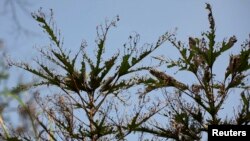DAKAR —
Thousands of people have fled their homes in northern Liberia following an invasion of caterpillars - which have overtaken houses and schools, destroyed crops and contaminated water sources. The United Nations Food and Agriculture Organization (FAO) says these attacks are becoming more frequent in Liberia and the government needs to put in place an early warning system to stop the invasions from reaching such catastrophic levels.
Residents of at least 25 villages and towns in the forested areas of Lofa and Gbarpolu counties have been fleeing en masse since early June to escape the trail of excrement that the caterpillars leave behind.
“We are afraid. You see here, the caterpillars are all over and there is nowhere to sleep. I am leaving with my children to a different community," explained Mary Tolbert who lives in Gbarpolu County.
Jeremiah Toe, a nurse in one of the affected villages, says the caterpillars pose a serious public health problem.
A local plague
“The situation is alarming. We have informed the Ministry of Health," he said. "As you can see, the caterpillars are taking over the homes of residents. They have polluted the creeks…Even our clinic has been attacked by the caterpillars.”
Residents and local authorities say the caterpillars have also taken over classrooms, forcing many schools in the area to shut down. Fresh water sources have become so contaminated with caterpillar feces that they are no longer safe to drink from. Farmers say some of their crops have been destroyed.
This is not the first time caterpillars have attacked the region. A 2009 invasion caused the government to declare a state of emergency. Smaller invasions were seen in 2011 and 2012.
Early warning systems
Past attacks have been controled through the spraying of pesticides. While the pesticides are said to be safe for both humans and crops, experts say there is a better way.
Winfred Hammond, a senior entomologist at the U.N. Food and Agriculture Organization, has helped with containment efforts on previous outbreaks.
“The biggest concern is the fact that this is becoming a regular occurrence… It’s about time we seriously consider putting in place early warning systems and look at how we can contain or check this problem from becoming a big national concern. To prevent it as we’ve seen, you need to have a good surveillance system in place
Hammond says the caterpillars have not yet been identified but are believed to come from a species of moth known as Achaea catocaloides, which is occasionally found in smaller numbers in Guinea, Benin, Ivory Coast and a few other West and East African countries. He says it is still not known why the caterpillars favor this particular region of Liberia or why the invasions are becoming more frequent.
Liberian authorities, after weeks of “monitoring” the situation, say they have finally begun spraying pesticides. They have reached five of the affected communities and plan to continue spraying throughout the week.
Prince Collins contributed to this story from Liberia.
Residents of at least 25 villages and towns in the forested areas of Lofa and Gbarpolu counties have been fleeing en masse since early June to escape the trail of excrement that the caterpillars leave behind.
“We are afraid. You see here, the caterpillars are all over and there is nowhere to sleep. I am leaving with my children to a different community," explained Mary Tolbert who lives in Gbarpolu County.
Jeremiah Toe, a nurse in one of the affected villages, says the caterpillars pose a serious public health problem.
A local plague
“The situation is alarming. We have informed the Ministry of Health," he said. "As you can see, the caterpillars are taking over the homes of residents. They have polluted the creeks…Even our clinic has been attacked by the caterpillars.”
Residents and local authorities say the caterpillars have also taken over classrooms, forcing many schools in the area to shut down. Fresh water sources have become so contaminated with caterpillar feces that they are no longer safe to drink from. Farmers say some of their crops have been destroyed.
This is not the first time caterpillars have attacked the region. A 2009 invasion caused the government to declare a state of emergency. Smaller invasions were seen in 2011 and 2012.
Early warning systems
Past attacks have been controled through the spraying of pesticides. While the pesticides are said to be safe for both humans and crops, experts say there is a better way.
Winfred Hammond, a senior entomologist at the U.N. Food and Agriculture Organization, has helped with containment efforts on previous outbreaks.
“The biggest concern is the fact that this is becoming a regular occurrence… It’s about time we seriously consider putting in place early warning systems and look at how we can contain or check this problem from becoming a big national concern. To prevent it as we’ve seen, you need to have a good surveillance system in place
Hammond says the caterpillars have not yet been identified but are believed to come from a species of moth known as Achaea catocaloides, which is occasionally found in smaller numbers in Guinea, Benin, Ivory Coast and a few other West and East African countries. He says it is still not known why the caterpillars favor this particular region of Liberia or why the invasions are becoming more frequent.
Liberian authorities, after weeks of “monitoring” the situation, say they have finally begun spraying pesticides. They have reached five of the affected communities and plan to continue spraying throughout the week.
Prince Collins contributed to this story from Liberia.





